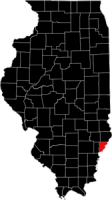Wabash County

Location of Wabash County in Illinois.

Location of Wabash County in Illinois.
Combining science and art, ornithologist Robert Ridgway tried to bring scientific order to the description of the colors of birds. When he published this Color Standards and Nomenclature in 1912, it was actually his second version. The first one, Nomenclature of Colors for Naturalists, published in 1886, included hand-colored plates. Ridgway was dissatisfied with his first attempt, calling it “altogether inadequate in the number of colors presented.” It took more than 25 years, but he finally published a new edition that featured 53 colored plates and 1,115 named colors. “The reproduction of the plates has been a difficult matter, involving not only expensive experimentation, but more than three years of unremitting labor,” he wrote in the book’s preface.
Ridgway was born in Mt. Carmel on the Wabash River in 1850. He spent his whole career at the Smithsonian Institution, starting in 1874 when he was just 24 years old. In 1883, he founded the American Ornithologist’s Union, a professional organization dedicated to the study of birds. He authored an eight-volume set of books on North American birds and penned a two-volume set, Birds of the Galapagos Archipelago. He also illustrated his books with his own paintings of birds. He returned to Illinois in retirement in 1916, choosing to live in Olney, not far from where he was born. He passed away in 1929. Before he died, Ridgway set aside 16 acres of his own land for native plants and birds that today is the Robert Ridgway Memorial Arboretum and Bird Sanctuary.